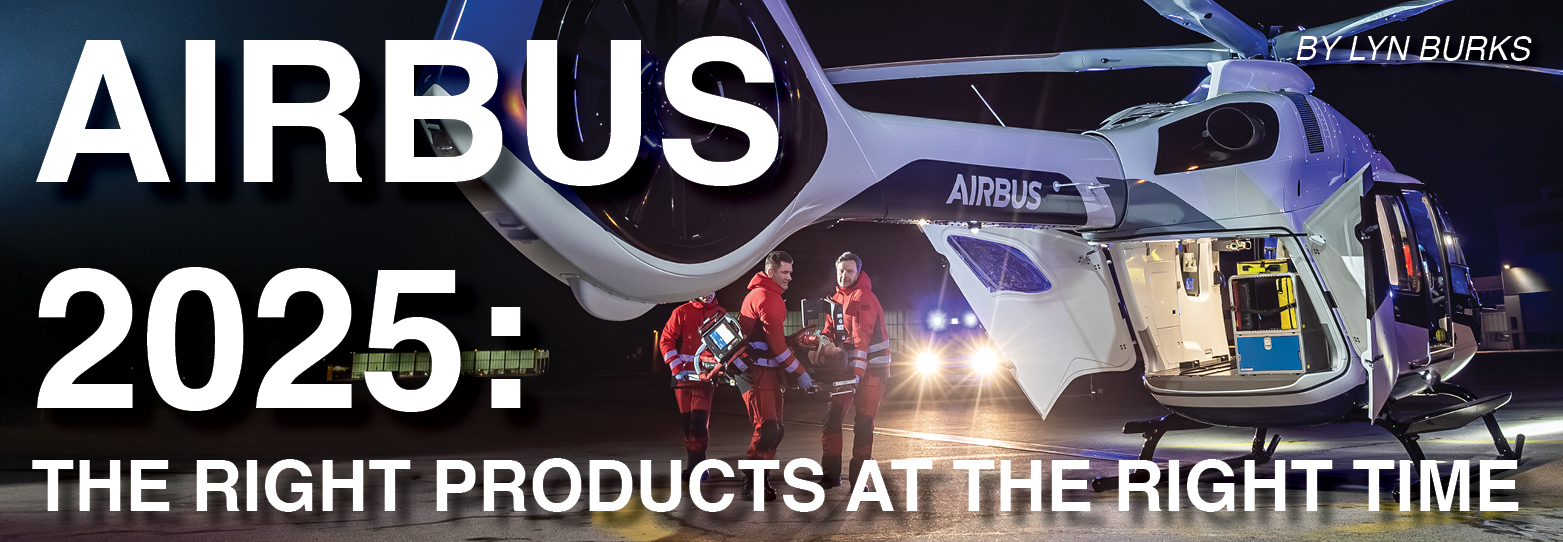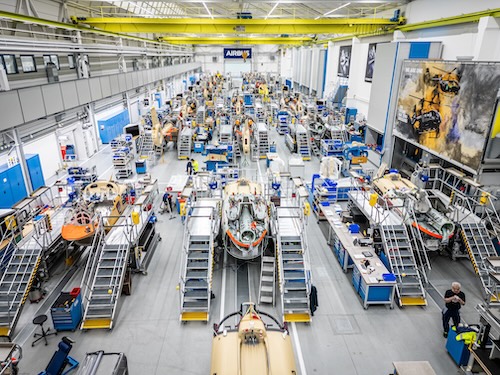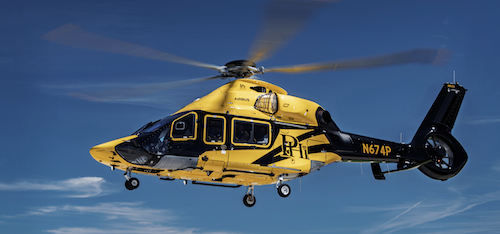|
Jun
02
2025
|
|
Posted 185 days ago ago by Admin
|
|

Just prior to Verticon 2025, Rotor Pro visited Donauwörth, Germany, to learn what the vertical lift industry can expect to see in 2025 from Airbus Helicopters. With nearly 8,000 employees, the facility is home to Airbus Helicopters’ second largest manufacturing facility in the world. Donauwörth is home to not only the development center of the CityAirbus NextGen eVTOL prototype, but also the production lines of the H135, H145, and the military NH90 helicopters.
Looking into the rear-view mirror, Airbus Helicopters had a strong 2024. 455 gross orders (net: 450) showed a steady market growth with a strong performance last year for its light, light twin-engined, and heavy helicopters. Orders came from 182 customers in 42 countries. The Company delivered 361 helicopters in 2024, resulting in a preliminary 57% share of the civil and parapublic market.
“Airbus Helicopters’ order intake in 2024, with an increase bordering 10 percent in units for the second year in a row, highlights its stable growth in a complex global environment,” said Bruno Even, CEO of Airbus Helicopters. “I would like to thank our customers for continuing to place their trust in Airbus Helicopters in 2024,” he added.
H140 Takes Center Stage at Verticon
Without a doubt, the biggest news coming out of the manufacturer was the launch of its newest light-twin helicopter, the H140.
Perfectly situated between the H135 and the H145, the manufacturer sought to find a balance of size and cost. “The major motivation is the clear market demand for efficient, high performance helicopters with larger cabins, low operating cost, and an attractive acquisition cost. The H140 meets this demand with a spacious cabin that can seat up to six passengers comfortably, in a helicopter that’s easy to maintain.” said Dr. Dirk Petry, VP of Airbus H135 and H140 Programs.

Very popular in the world of helicopter emergency medical services (HEMS) operations, the H135 and H145 make up a significant share of the global market. Listening to what their HEMS customers had to say, Airbus held workshops, as well as performed meetings and interviews to learn more about the needs of their clients. “We’ve been working with some of the biggest EMS operators in the world,” says Stefan Bestle, H140 product manager. “The H140 really reflects what the customer requires.”
Key features of the H140:
• T-tail design with an optimized Fenestron, reducing noise levels
• Five-blade, bearingless main rotor, enhancing stability and efficiency
• More powerful engines for improved performance
• Expanded cabin and large windows for greater visibility and passenger comfort
• Improved accessibility with rear clamshell doors and a raised tail, simplifying stretcher and medical equipment loading
Unveiled at Verticon 2025 in Dallas, Texas, apparently the planning and calculations on the part of Airbus Helicopters paid off as the OEM received more than 74 commitments for the H140.
Emergency medical services will be the first mission to enter service for the H140. Major HEMS operators in the U.S. and in Europe — Global Medical Response, ADAC Luftrettung, ÖAMTC Flugrettung, Air Methods, Stat Medevac, Metro Aviation, and DRF Luftrettung — signed orders and letters of intent for the helicopter.
“The H140 was designed by customers. Signing with some of the world’s most prominent EMS operators shows that the H140 has hit the mark,” said CEO Even. “I would like to thank our customers for placing their trust in Airbus. The essential missions they perform with our helicopters is a tremendous source of pride for everyone in the company. VERTICON has proved to be a key moment in the year to connect with our customers and to celebrate what they do,” he added.
The H140 production will be integrated into the H135 and H145 lines in the Donauwörth plant and they anticipate the ability to produce 40 aircraft per year. With the first prototype having flown in June of 2023, Airbus plans on first deliveries to HEMS operators in 2028, and an ACH (corporate) version to arrive in 2030.

H160 Goes Global
The Airbus H160 has recently achieved notable milestones, reflecting its growing adoption and operational success:
Offshore Operations with PHI Aviation: Following a multi-year route proving partnership with Shell plc, PHI Aviation commenced commercial offshore operations with the H160this past March, servicing Shell plc in the Gulf of Mexico. Following the 300 hours of route-proving flights, PHI now has 12 H160-type-rated pilots and 12 H160-qualified A&P mechanics servicing the contract. Airbus has plans to support operations in the western hemisphere by installing an H160 FFS (full flight simulator) by 2026 at the Helisim simulation center in Grand Prairie, Texas.
“This is a long anticipated milestone that will bring material advantages to our offshore operations in the Gulf of America,” said Tony Cramp, Shell’s vice president of aircraft. “The H160 represents a new generation of rotorcraft with the potential to enhance safety and passenger experience for our people, while giving our business greater operational capability and availability, driving business efficiencies. We look forward to seeing how it performs when in full regular service, with a view to replication in other regions.”
Capable of performing wide-ranging missions including law enforcement, offshore transportation, search and rescue, private and business aviation, and emergency medical services, the H160 has entered into service in Brazil, Canada, Japan, Malaysia, Philippines, Saudi Arabia, U.S., and many European countries.
On 12 March 12, 2025, the New York State Police placed an order for one H160 and three H145 helicopters. This procurement marks them as the first U.S. law enforcement agency to incorporate the H160 into their fleet, aiming to enhance their operational capabilities with advanced technology and versatility.
Also, Omni Taxi Aéreo has entered into a multi-services HCare Initial contract to support the entry into service of three H160 helicopters. These aircraft are expected to begin operations in May, providing offshore transportation services for Brazil's energy sector.

These recent developments highlight the H160's versatility across various sectors, including law enforcement and energy, solidifying its position in the global helicopter market.
CityAirbus NextGen eVTOL Paused
In contrast, Airbus has decided to pause the development of its CityAirbus NextGen eVTOL aircraft.
In late January 2025, Airbus Helicopters announced a pause in the development of the CityAirbus NextGen program. The decision was attributed to the current limitations in battery technology, which are insufficient to meet the company's ambitions for electric vertical take-off and landing (eVTOL) aircraft.
Despite the program's pause, flight testing of the CityAirbus NextGen prototype has continued. As of early March 2025, the aircraft has been conducting weekly flights at an undisclosed location to expand its flight envelope and gather valuable data for future advancements.
Airbus remains committed to innovation in urban air mobility and intends to resume the CityAirbus NextGen program once technological advancements, particularly in battery performance, align with the project's requirements.
In summary, while the Airbus H160 helicopter continues to achieve operational successes and expand its global footprint, the CityAirbus NextGen eVTOL aircraft's development has been temporarily halted, pending advancements in essential technologies.
Pioneer Lab: Targeting Hybrid Electric Propulsion
The Airbus Helicopters Pioneer Lab is at the forefront of aviation innovation, focusing on cutting-edge technologies that enhance the efficiency, safety, and sustainability of rotorcraft. As part of Airbus’ broader research and development efforts, the Pioneer Lab explores advanced aerodynamics, hybrid propulsion, and intelligent systems to push the boundaries of helicopter performance.
One of the most significant advancements emerging from the Pioneer Lab is the development of hybrid-electric propulsion systems. Airbus is actively testing itsR Eco-mode technology, which allows one of the helicopter’s engines to be temporarily shut down during cruise flight, significantly reducing fuel consumption and emissions. This innovation aligns with Airbus’ commitment to sustainable aviation and reducing its carbon footprint by reducing fuel consumption and carbon dioxide emissions by up to 30%.

Another key focus is autonomous flight technology, which aims to improve operational safety and efficiency. By integrating advanced artificial intelligence (AI), automation, and advanced camera sensors, Airbus is developing helicopters capable of assisted and even fully autonomous flight, reducing pilot workload and increasing overall reliability.
Additionally, the Pioneer Lab is experimenting with innovative rotor designs to enhance lift efficiency and reduce noise pollution. Concepts such as optimized blade shapes and active rotor control systems could lead to quieter and more fuel-efficient helicopters, making them better suited for urban air mobility applications.
By continuously exploring next-generation materials, digitalized maintenance solutions, and enhanced avionics, the Airbus Helicopters Pioneer Lab is shaping the future of rotorcraft, ensuring they are safer, more sustainable, and better integrated into modern airspace. These innovations will redefine helicopter operations for both commercial and defense applications.
READ MAR/APR ISSUE OF ROTOR PRO
READ MORE ROTOR PRO: https://justhelicopters.com/Magazine
WATCH ROTOR PRO YOUTUBE CHANNEL: https://buff.ly/3Md0T3y
You can also find us on
Instagram - https://www.instagram.com/rotorpro1
Facebook - https://www.facebook.com/rotorpro1
Twitter - https://twitter.com/justhelicopters
LinkedIn - https://www.linkedin.com/company/rotorpro1